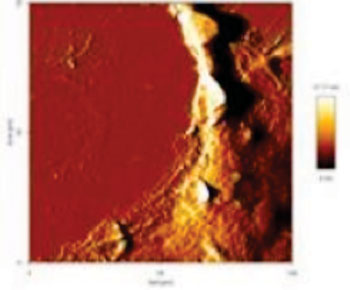Neuronal Cytoskeleton and Cytomechanics Shown to Be Altered by Cranial Radiotherapy at a Specific Dose
By MedImaging International staff writers
Posted on 07 Aug 2014
Chinese researchers have discovered that radiation-induced neuronal injury was more apparent after cranial radiation therapy.Posted on 07 Aug 2014
Cranial radiotherapy is one of the most significant therapeutic strategies for the treatment of various types of primary and metastatic brain tumors. Although traditional photon irradiation has significantly enhances the treatment of cancer, the central nervous system is prone to damage after high-dose irradiation, resulting in severe delayed or progressive nervous tissue injury.

Image: Under the atomic force microscope, the cytoskeletal protein structures became fuzzy or even collapsed after X-ray irradiation (Photo courtesy of Neural Regeneration Research journal).
The issues regarding brain radiation injury have been widely discussed, and recent studies have emphasized changes in pathomorphology. However, the underlying mechanism remains elusive, according to the invesigators, from the School of Stomatology, Lanzhou University (Lanzhou, Gansu Province, China).
Under atomic force microscopy, the neuronal membrane appeared rough and neuronal rigidity had increased. The depolymerization, misfolding, or denaturation of microtubule-associated proteins might contribute to the destruction of the nutrient transport channel within cells after radiation injury. Moreover, some hidden apoptosis-related genes are released through the regulation of several signals, thereby activating apoptosis and inducing acute radiation injury.
These research data also revealed that X-rays generated much more sever radiation injury to cortical neurons than a heavy ion beam, suggesting that the heavy ion beam has a biologic advantage over X-rays. This could provide a hypothetic foundation for effectively improving the protection of normal brain tissue in future cranial radiotherapy, according to the scientists.
This article was published June 1, 2014, in the journal Neural Regeneration Research.
Related Links:
Lanzhou University














